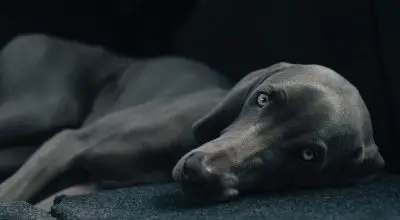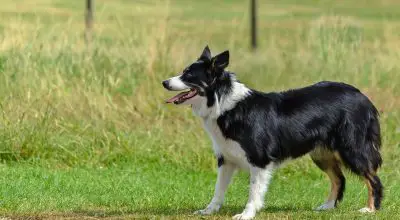You probably already know the equipment needed for a dog agility course may be quite costly since you have probably researched it. The good news is that a high-quality obstacle course for dogs need not cost an arm and a leg to construct. It’s effortless to make a dog obstacle course. Your dog will appreciate your consideration and the hours of focused, boredom-busting pleasure you provided by making dog obstacle courses for them.
What Is a Dog Obstacle Course?
Dog agility is an activity in which you must guide your dog through some kind of set of obstacles in a predetermined amount of time. Tubes, weaving poles, wheel leaps, seesaws, and halt boards are only some common obstacles in the course of 14–20. Trials feature races between competitors and their dogs on specially designed courses. Your dog can only follow your verbal and nonverbal instructions to get where you’re going.
Why Do Dogs Need Agility Training?
Dogs need agility training because, together with the handler, they can reap various benefits from it. Training a dog’s agility utilizes the instincts of this four-legged animal. To activate a dog’s natural hunting instinct, agility courses simulate the challenges a dog in the wild could encounter when searching for a meal.
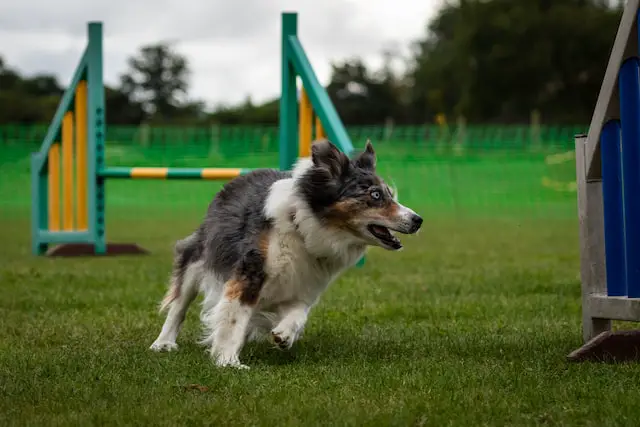 Another reason why dogs need agility training is that this canine event is a healthy way for them to work out. Many dogs benefit significantly from an obstacle course’s intensive physical activity. Athletic challenges are beneficial for dogs since they aid in maintaining healthy body weight, developing stamina, and reinforcing bone and joint structures. Plus, the mental challenges of an agility course force dog to use their training in novel contexts.
Another reason why dogs need agility training is that this canine event is a healthy way for them to work out. Many dogs benefit significantly from an obstacle course’s intensive physical activity. Athletic challenges are beneficial for dogs since they aid in maintaining healthy body weight, developing stamina, and reinforcing bone and joint structures. Plus, the mental challenges of an agility course force dog to use their training in novel contexts.
Dog owners also take advantage of dogs’ agility courses by maintaining their fitness through agility drills. The exercise will involve moving gently with your dog rather than rushing through a tunnel or dodging poles in a weave. You’ll get some mental exercise, too, as you focus on your dog’s performance and react quickly to keep him on track and achieve his best possible time. Agility training for dogs is excellent for you and your dog since it challenges your cardiovascular system, strengthens your muscles, and stimulates your mind.
Finally, agility training for dogs also enhances the link between dogs and humans. Having spent so much time together learning one other’s languages, dogs and humans form a special bond. Off the course, the dog’s improved demeanor can be attributed to his trust in his master during training.
Make Sure The Obstacle Course Is Safe For Your Dog
A temperament assessment can help determine whether the dog is a better match for agility. If the dog is energetic, fond of exploring and following instructions, and can get along well with canine companions, then one such skill that would work well is agility.
Other people and things besides your dog need to be included in the training. Your participation is crucial to the procedure’s success. You don’t need to be a speedster to do dog agility. Training and developing solid communication skills will allow you and your dog to engage in the agility activity.
Pick The Right Equipment For Your Dog Obstacle Course
Leaps, swirl patterns, and tunnels are standard components of agility equipment. Using every piece of competitive gear is optional; you can also stick to the fundamentals. Perhaps, the following are the most common equipment used in different obstacle courses for dogs.
Tunnel Obstacles
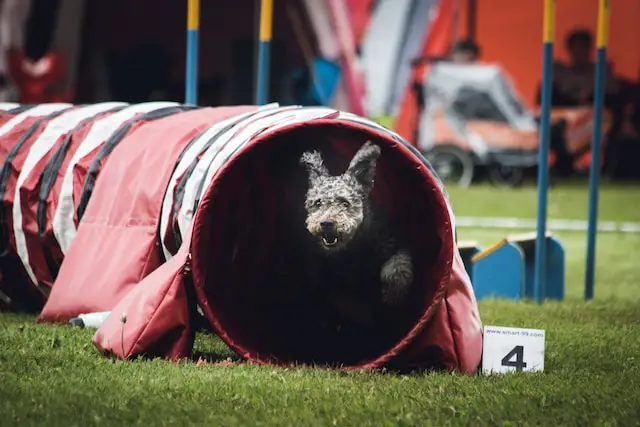 Open or closed tunnels are available for the dogs to travel through. When we say this, we are referring to the ends of the tunnel. Regarding AKC standards, open tunnels have different rules than closed tunnels.
Open or closed tunnels are available for the dogs to travel through. When we say this, we are referring to the ends of the tunnel. Regarding AKC standards, open tunnels have different rules than closed tunnels.
Weaving Obstacles
Dogs in this area do a weaving pattern between left and suitable poles roughly two feet apart, depending on the style. The weave poles are the most challenging dog agility obstacle to teach. Given the variety of methods this training can be taught, you’ll undoubtedly need professional guidance with the training.
You can get started with a few plant pegs and a two-foot gap in your yard. Ensure your dog leaves the pole on the left side of the one that separates the first and second.
Jumping Obstacles
Jumping is a great activity when training your dog for obstacles. Curtain rods and laundry baskets can help your companion make short, uncomplicated hops. If you have any leftover PVC pipes or cups from a plumbing project, you might use those. These are great for making your own do-it-yourself dog obstacle course! Setting up a jump with adjustable rungs allows you to tailor the obstacle to your dog’s skill level.
Ramps
Including ramps in your dog’s obstacle training may be a lot of fun. Building a simple slope for your dog to run upward out of thick plywood with cinder blocks will help him remain safe. But you’ll want to be sure that the ramp can withstand your dog’s weight.
How to Set Up a Dog Obstacle Course?
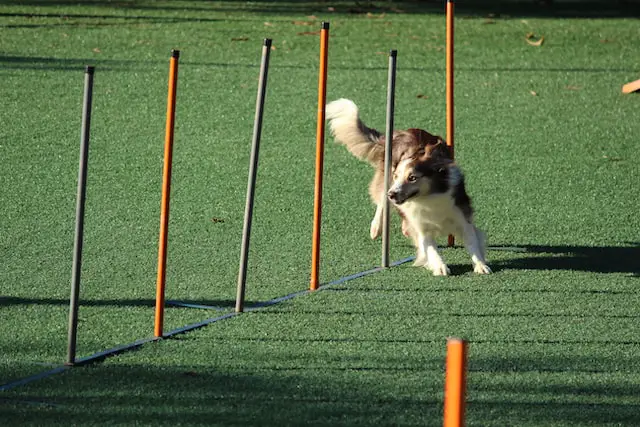 In setting up a dog obstacle course, you must take out your creativity and skills in creating a do-it-yourself project. Among the most recognizable features of a dog obstacle course are the PVC poles and hurdles used in the sport. To do that, you need to prepare the following tools:
In setting up a dog obstacle course, you must take out your creativity and skills in creating a do-it-yourself project. Among the most recognizable features of a dog obstacle course are the PVC poles and hurdles used in the sport. To do that, you need to prepare the following tools:
- 20 feet 1” PVC Pipe 40
- 2 pieces 1” PVC Tee 4-Way
- 2 pieces 1” PVC Slip Tee
- 6 pieces 1” PVC End Cap
- 6 pieces ½” Head Screws Round Washer
- Cutting tools like an electric saw or handsaw
- Power DrillMallet or Hammer
Here is a guide on how to make a dog obstacle course for your dog.
- You need eight pieces of pipe; four are 12 inches long, two are 35 inches long, and two are 45 inches long.
- The two 35-inch sections should be inserted into the 4-way tees’ tops, with the 12-inch protruding portions on either side. Position one of the 45-inch parts in the space created by the hurdle’s two arms.
- Finish up the hurdle by attaching an end cap to each of the 12′′ foot sections. If necessary, you might use a hammer or mallet when fitting the pieces together.
- Use adhesive if you must, but remember that you may need to take the obstacle apart at some point. Consider using screws instead. Even if the piping is tightly assembled, the hurdle’s bottom needs to be held in place to prevent it from disintegrating.
- You should drive a screw into each joint where a pipe crosses the ground perpendicularly using a power drill. If you only have a power drill and a screw, you might find this to be a little challenging. To avoid this, think about drilling the hole first with a drill bit. After the screws are tightened, the frame’s base should be solid.
Switch Parts of the Dog Obstacle Course After Some Time
Once you notice that your dog is in the habit of things and is already familiar with every obstacle through listening and following commands, then it is time to move the obstacles around to switch things up. It will be a big help for your pooch in the learning process as he will not do repetitions of steps to overcome the initial challenge.
How about leveling up the challenges? Include some bonus activities in your dog’s obstacle course. It would be more enjoyable to let him get to recover a tennis ball or allow him to jump into the kiddie pool to get a floating toy. Aside from that, spraying the obstacle course may make your pooch comfortable during training in the heat. But, make sure not to wet the ramps or your dog could fall.
Dog Obstacle Course For Border Collie
Many dogs with behavioral issues related to boredom or worry find relief by completing an agility course. Dogs are easily intimidated, so it’s best to work by praising them and rewarding good behavior.
Border Collies excel at agility courses’ physical and mental challenges as a breed. The dog’s endurance, athleticism, bravery, and obedience are all tested in agility courses, but the main goal is to have great times.
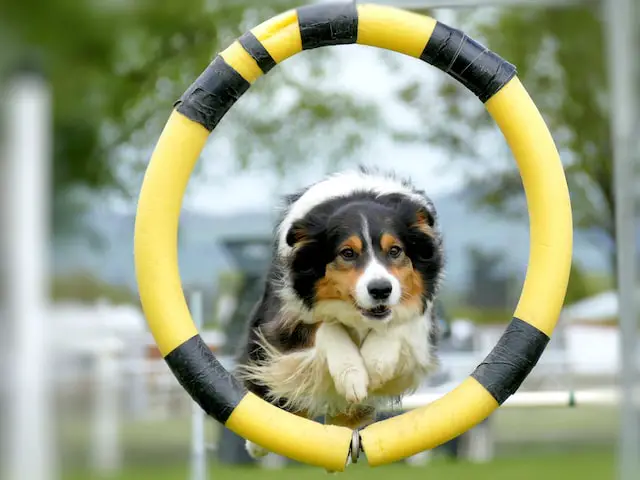 An agility course will put your dog through its paces with obstacles like weaving poles, hurdles, tunnels, long leaps, high balancing, hoops, A-frame, a sea-saw, and a “stay” station. During the process of learning these abilities, the dog should look to its owner for cues. That’s all there is to it, and you’ll have a blast in the process!
An agility course will put your dog through its paces with obstacles like weaving poles, hurdles, tunnels, long leaps, high balancing, hoops, A-frame, a sea-saw, and a “stay” station. During the process of learning these abilities, the dog should look to its owner for cues. That’s all there is to it, and you’ll have a blast in the process!
Border Collies can be trained to run agility with some essential obedience equipment and some makeshift obstacles such as follows:
- Use delectable snacks the size of peas or a tug toy to encourage the dog.
a bag or goodie pouch for convenience - “pause square” will be marked out by four pieces of pipe
- little table
- used tire
- broom and a few bricks or a barrier
- Chamber
- swing or A-frame
Conclusion: To Build or Not To Build?
Making a dog obstacle course for your dog is not a challenging task. If you already know which components you want to utilize, you can arrange them in any order you wish! Think of putting it up similarly to how you would a person’s private workout.
Moreover, considering your dog’s feeling of excitement and enjoyment will necessitate you to build an obstacle course for them. Use little treats as incentives to encourage your dog throughout the course, and after some controlled practice time, give him some unorganized freedom to run around in. The most crucial point is to ensure your dog enjoys himself while completing the tasks on the obstacle course.

